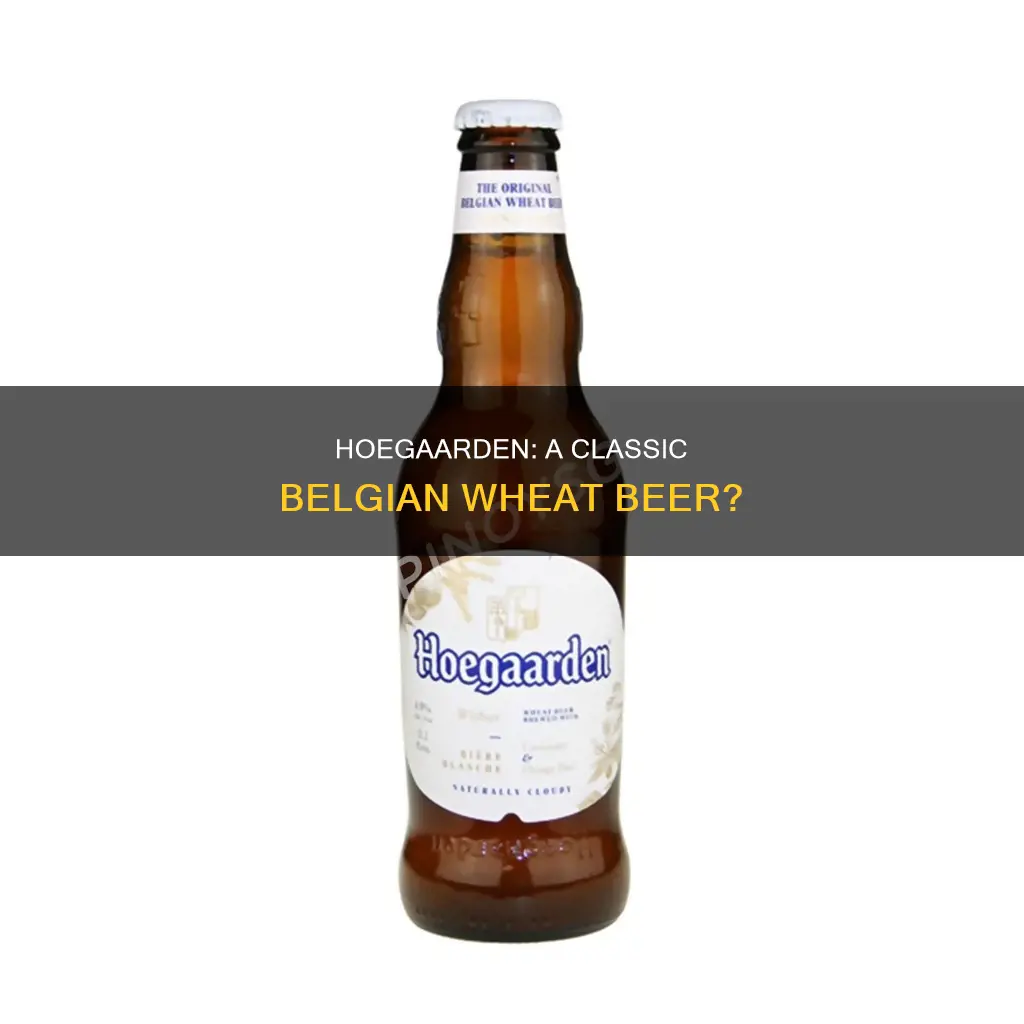
Hoegaarden is a Belgian witbier, which is different from a wheat beer. It is brewed with wheat, hops, yeast, coriander, and dried Curaçao orange peel. Hoegaarden is unfiltered, giving it a cloudy, pale gold appearance and a lasting white head. The beer has a fruity, spicy flavor profile with hints of orange peel, banana, clove, and bubblegum. It is known for its refreshing qualities and is often consumed with a slice of orange or lemon.
| Characteristics | Values |
|---|---|
| Type of Beer | Witbier (white beer) |
| Ingredients | Yeast, wheat, hops, coriander, dried Curaçao orange peel |
| Alcohol Content | 4.9% |
| Appearance | Cloudy, pale gold |
| Taste | Light, slightly sweet and sour, citrus notes |
| Aroma | Peppery yeast, citrus, spice |
What You'll Learn

Hoegaarden is a witbier, not a wheat beer
The term "witbier" means "white beer" in English, and Hoegaarden is a classic example of this style. Witbiers are typically brewed with a mix of pale barley malt, unmalted wheat, and oats, resulting in a creamy mouthfeel. They are spiced with coriander and citrus notes, particularly from the addition of orange peel, and have a small amount of lactic acidity. The style is cloudy and golden in appearance due to its unfiltered process. Witbiers have a distinctive bready flavor and usually fall in the 4.5 to 5.5% ABV range.
On the other hand, wheat beers encompass a broader category that includes various styles such as weissbier, hefeweizen, and American wheat beer. These beers can have different characteristics depending on their specific style and place of origin. For example, German-style wheat beers often have banana and clove flavors, while American wheat beers tend to be simpler and less complex than their European counterparts.
Hoegaarden, specifically, is a refreshing, unfiltered witbier with a cloudy, pale gold appearance and a lasting white head. It has aromas of peppery yeast, citrus, and spice, with a classic witbier taste enhanced by the addition of orange peel and coriander. It has a relatively low ABV of 4.9%, making it highly drinkable.
The confusion between witbier and wheat beer may stem from the fact that both styles use wheat as a primary ingredient. However, the key distinction lies in the type of wheat used and the resulting flavor and appearance. Witbiers use unmalted wheat, which gives them a lighter body and a hazy or milky appearance, earning them the name "white beers." In contrast, wheat beers can use malted or unmalted wheat, depending on the style, and may have clearer or cloudier appearances depending on the filtration process.
Wheat in IPA Beer: What You Need to Know
You may want to see also

Hoegaarden's history and origin
Hoegaarden is a wheat beer, or witbier, that originated in the village of Hoegaarden, Belgium, which had been known for its witbieren (white beers) since the Middle Ages. In the 15th century, monks in Hoegaarden began experimenting with the addition of Curaçao orange peels and coriander to their wheat beer recipe, resulting in a distinct flavour that would become synonymous with the Hoegaarden name.
Over the centuries, the village of Hoegaarden became a thriving centre for brewing, with 38 breweries by 1758, serving its 2,000 villagers. However, changing tastes and the rise in popularity of bottom-fermented lagers and pilsners saw Hoegaarden's breweries gradually decline. By 1957, the last local wheat beer brewery, Tomsin, had closed its doors, bringing an end to Hoegaarden's 500-year-old brewing tradition.
It was at this point that Pierre Celis, a local milkman, decided to revive the ancient Hoegaarden recipe. In the late 1960s, Celis began brewing witbier in his hayloft, using traditional ingredients such as water, yeast, wheat, hops, coriander, and dried Curaçao orange peel. His brewery, called de Kluis, soon gained popularity, and by the 1980s, he had expanded his brewing operations to meet growing demand.
However, disaster struck in 1985 when a fire destroyed the brewery. Several brewers offered assistance, including Interbrew (now InBev), the largest brewer in Belgium. With their help, Celis was able to rebuild, but he eventually felt pressured to change the recipe to appeal to a wider audience. Unwilling to compromise the authenticity of his witbier, Celis sold the brewery to Interbrew and moved to the United States, where he continued to brew wheat beer according to the original Hoegaarden recipe.
Today, Hoegaarden is owned by brewing giant AB InBev and is enjoyed in 70 countries worldwide. While the scale and range of the beer have expanded, the marketing and branding have remained true to their distinct, history-rich origins.
Mashing Wheat Beer: A Guide to the Perfect Mash
You may want to see also

Ingredients and brewing process
Hoegaarden is a Belgian witbier, which is different from a wheat beer. Hoegaarden de-emphasizes hops and is unfiltered, giving it a hazy or milky appearance, which makes it a wit (white) beer.
The village of Hoegaarden had been known for its witbieren (white beers) since the Middle Ages. In the 19th century, the village had 13 breweries and nine distilleries. However, in 1957, the last local wheat beer brewery, Tomsin, closed its doors.
Pierre Celis, a milkman who had grown up next to the brewery and sometimes helped with brewing, decided ten years later to try to revive the style. He started a new brewery, called de Kluis, in his hay loft. Celis used the traditional ingredients of water, yeast, wheat, hops, coriander, and dried Curaçao orange peel known as Laraha.
The beer was called Hoegaarden, after Celis' hometown. It is made from malted barley, unmalted wheat, hops, coriander, and Curaçao orange peel. It is very pale in colour and hazy with a frothy head of foam. The aroma and taste are citrusy, fruity, spicy, and refreshing, with a light snappy bitterness. The beer is light-bodied, well-balanced, and mild in strength, with a deceptively mild amount of alcohol (4.9% ABV).
Hoegaarden gets its taste from three key factors. Firstly, it’s unfiltered, which gives it a milky or hazy appearance and thicker texture. Secondly, the recipe is lower in hops, substituting in orange and coriander. Finally, it’s “bottle-conditioned”, which means that a second round of yeast is added to the bottle to create carbonation.
Is Pacifico Beer Wheat-Based?
You may want to see also

Hoegaarden's taste and appearance
Hoegaarden is a witbier, which means "white beer". It is unfiltered, giving it a cloudy, pale gold appearance with a lasting white head. It has a milky or hazy look and a thicker texture. Hoegaarden is bottle-conditioned, which means that a second round of yeast is added to the bottle to create carbonation. This results in a zingy carbonation and a dry, almost quenching finish.
Hoegaarden has a refreshing citrus taste with hints of coriander and banana. It is lightly malted with a bit of an allspice/clove character. The taste is also described as having a "hint of lemon peel" and being "very light and floral". It is not heavy or gassy like many other wheat beers. Hoegaarden is also described as having a "yeasty bitterness" and a "sweet citrus finish".
The ingredients used in Hoegaarden include yeast, wheat, hops, coriander, and dried Curaçao orange peel. The coriander and orange give Hoegaarden its distinctive witbier taste. The beer also has a bubbly carbonation and a bit of tartness.
Hoegaarden is served in a sturdy, flat-bottomed hexagonal glass. The hexagon shape is designed to cultivate a sturdy foam, while the wider mouth allows the citrus and spice aromatics to be released as you sip.
IPAs and Wheat Beers: What's the Connection?
You may want to see also

Hoegaarden's ABV
Hoegaarden is a wheat beer, or witbier, which means "white beer". It has an ABV of 4.9%, which is relatively low and adds to its drinkability.
Hoegaarden is a refreshing, unfiltered wheat beer with a cloudy, pale gold appearance and a lasting white head. It has aromas of peppery yeast, citrus and spice, which give an indication of its classic witbier taste. This is enhanced by the addition of orange peel and coriander to the brew. The low ABV, bubbly carbonation, and a bit of tartness make it very drinkable.
The witbier style of beer is usually top-fermented, with a larger proportion of wheat in comparison to the amount of malted barley. In the Belgian variety, suspended yeast and wheat proteins cause the beer to look white and hazy. Hoegaarden is served with an orange slice, which may be to enhance the flavour (as Hoegaarden already contains orange peel), to appeal to women, or to hark back to a time when people put fruit flavours into their beers.
Hoegaarden was first created almost 600 years ago by monks in the Belgian village of Hoegaarden. The monks improved the taste of the beer by experimenting with botanicals and spices from around the world, including coriander and orange peel, which combine to make Hoegaarden’s unique and delicious flavour.
Dark Beers and Wheat: What's the Connection?
You may want to see also
Frequently asked questions
Yes, Hoegaarden is a wheat beer. It is also a witbier, which means "white beer" in Dutch.
Witbiers are made with a minimum of 50% unmalted wheat, which gives them a lighter, grainier flavour than wheat beers. They also tend to be unfiltered, giving them a cloudy, milky or hazy appearance.
Hoegaarden has a soft, light and slightly sweet and sour taste, with subtle citrus notes. It is also spiced with coriander and orange peel, and has a dry, crisp finish.
Hoegaarden was first brewed in the village of Hoegaarden, Belgium, in 1445. The recipe was developed by monks, who added orange peel and coriander to the brew, creating a unique, refreshing flavour and aroma.







